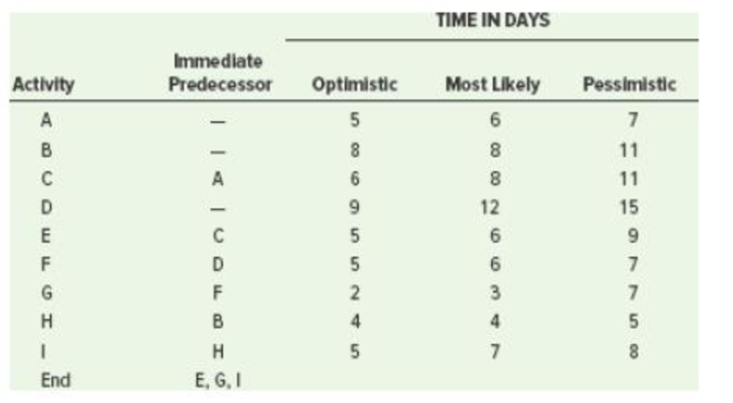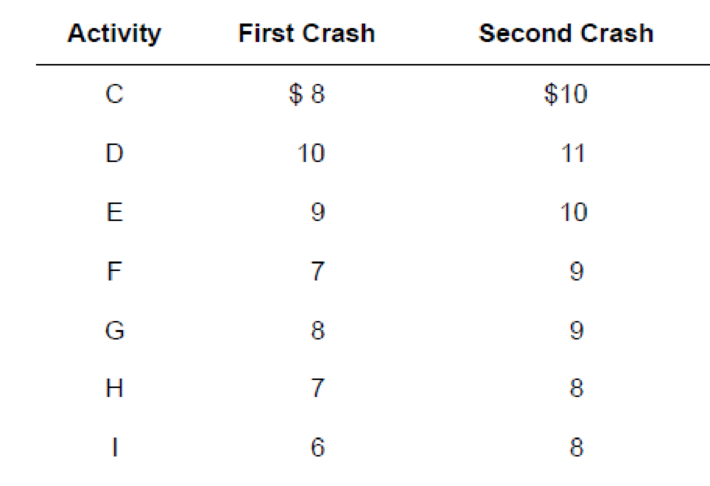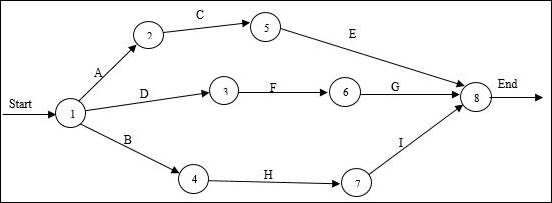
Concept explainers
Three recent college graduates have formed a
a. Draw the precedence diagram.
b. What is the probability that the project can be completed in 24 days or less? In 21 days or less?
c. Suppose it is now the end of the seventh day and that activities A and B have been completed while activity D is 50 percent completed. Time estimates for the completion of activity D are 5, 6, and 7. Activities C and H are ready to begin. Determine the probability of finishing the project by day 24 and the probability of finishing by day 21.

d. The partners have decided that shortening the project by two days would be beneficial, as long as it doesn’t cost more than about $20,000. They have estimated the daily crashing costs for each activity in thousands, as shown in the following table. Which activities should be crashed, and what further analysis would they probably want to do?

a)
To draw: A precedence diagram.
Answer to Problem 7P
Precedence diagram:

Explanation of Solution
Given information:
| Activity | Immediate Predecessor | Optimistic time | Most likely time | Pessimistic time |
| A | 5 | 6 | 7 | |
| B | 8 | 8 | 11 | |
| C | A | 6 | 8 | 11 |
| D | 9 | 12 | 15 | |
| E | C | 5 | 6 | 9 |
| F | D | 5 | 6 | 7 |
| G | F | 2 | 3 | 7 |
| H | B | 4 | 4 | 5 |
| I | H | 5 | 7 | 8 |
| End | E, G, I |
| Activity | First crash | Second crash |
| C | $ 8.00 | $ 10.00 |
| D | $ 10.00 | $ 11.00 |
| E | $ 9.00 | $ 10.00 |
| F | $ 7.00 | $ 9.00 |
| G | $ 8.00 | $ 9.00 |
| H | $ 7.00 | $ 8.00 |
| I | $ 6.00 | $ 8.00 |
Precedence diagram:

The precedence diagram is drawn from the first task till the last task. The activities are placed from left to right. The directions are represented with arrows to indicate the relationship between activities. The arrows are represented with the activity name.
b)
To determine: The probability at which the projected can be completed in 24 days or less and 21 days or less.
Answer to Problem 7P
24 days or less = 0.9686
21 days or less = 0.2350
Explanation of Solution
Given information:
| Activity | Immediate Predecessor | Optimistic time | Most likely time | Pessimistic time |
| A | 5 | 6 | 7 | |
| B | 8 | 8 | 11 | |
| C | A | 6 | 8 | 11 |
| D | 9 | 12 | 15 | |
| E | C | 5 | 6 | 9 |
| F | D | 5 | 6 | 7 |
| G | F | 2 | 3 | 7 |
| H | B | 4 | 4 | 5 |
| I | H | 5 | 7 | 8 |
| End | E, G, I |
| Activity | First crash | Second crash |
| C | $ 8.00 | $ 10.00 |
| D | $ 10.00 | $ 11.00 |
| E | $ 9.00 | $ 10.00 |
| F | $ 7.00 | $ 9.00 |
| G | $ 8.00 | $ 9.00 |
| H | $ 7.00 | $ 8.00 |
| I | $ 6.00 | $ 8.00 |
Formula to calculate expected time and variance:
Calculation of expected time and variance:
| Activity | Optimistic time | Most likely time | Pessimistic time | Expected time | Standard deviation | Variance |
| A | B | C | (A+(4*B)+C)/6 | (C-A)/6 | (C-A)^2/6^2 | |
| A | 5 | 6 | 7 | 6 | 0.333 | 0.111 |
| B | 8 | 8 | 11 | 8.5 | 0.500 | 0.250 |
| C | 6 | 8 | 11 | 8.17 | 0.833 | 0.694 |
| D | 9 | 12 | 15 | 12 | 1.000 | 1.000 |
| E | 5 | 6 | 9 | 6.33 | 0.667 | 0.444 |
| F | 5 | 6 | 7 | 6 | 0.333 | 0.111 |
| G | 2 | 3 | 7 | 3.5 | 0.833 | 0.694 |
| H | 4 | 4 | 5 | 4.17 | 0.167 | 0.028 |
| I | 5 | 7 | 8 | 6.83 | 0.500 | 0.250 |
Calculation of expected duration, variance and standard deviation for each path:
A-C-E:
D-F-G:
B-H-I:
Calculation of z value for all paths:
Formula:
24 days or less:
A-C-E:
Since z value is greater than +3.00, probability of completion is 1.00.
D-F-G:
From the standard normal distribution table,
The probability value for (z = 1.86) is 0.9686.
B-H-I:
Since z value is greater than +3.00, probability of completion is 1.00.
Probability of completion in 24 days or less:
The probability at which the project can be completed in 24 days or less is 0.9686.
21 days or less:
A-C-E:
From the standard normal distribution table,
The probability value for (z = 0.45) is 0.6736.
D-F-G:
From the standard normal distribution table,
The probability value for (z = -0.37) is 0.3557.
B-H-I:
From the standard normal distribution table,
The probability value for (z = 2.07) is 0.9808.
Probability of completion in 21 days or less:
The probability at which the project can be completed in 21 days or less is 0.2350.
c)
To determine: The probability of completing the project by day 24 and day 21.
Answer to Problem 7P
Day 24 = 0.9328
Day 21 = 0.0186
Explanation of Solution
Given information:
- At the end of 7th day activities A and B are completed and D is 50% completed.
- Time estimates of activity D completion are 5, 6 and 7.
- Activities C and H are ready to begin.
| Activity | Immediate Predecessor | Optimistic time | Most likely time | Pessimistic time |
| A | 5 | 6 | 7 | |
| B | 8 | 8 | 11 | |
| C | A | 6 | 8 | 11 |
| D | 5 | 6 | 7 | |
| E | C | 5 | 6 | 9 |
| F | D | 5 | 6 | 7 |
| G | F | 2 | 3 | 7 |
| H | B | 4 | 4 | 5 |
| I | H | 5 | 7 | 8 |
| End | E, G, I |
| Activity | First crash | Second crash |
| C | $ 8.00 | $ 10.00 |
| D | $ 10.00 | $ 11.00 |
| E | $ 9.00 | $ 10.00 |
| F | $ 7.00 | $ 9.00 |
| G | $ 8.00 | $ 9.00 |
| H | $ 7.00 | $ 8.00 |
| I | $ 6.00 | $ 8.00 |
Formula to calculate expected time and variance:
Calculation of expected time and variance:
| Activity | Optimistic time | Most likely time | Pessimistic time | Expected time | Standard deviation | Variance |
| A | B | C | (A+(4*B)+C)/6 | (C-A)/6 | (C-A)^2/6^2 | |
| A | 5 | 6 | 7 | 6 | 0.333 | 0.111 |
| B | 8 | 8 | 11 | 8.5 | 0.500 | 0.250 |
| C | 6 | 8 | 11 | 8.17 | 0.833 | 0.694 |
| D | 5 | 6 | 7 | 6 | 0.333 | 0.111 |
| E | 5 | 6 | 9 | 6.33 | 0.667 | 0.444 |
| F | 5 | 6 | 7 | 6 | 0.333 | 0.111 |
| G | 2 | 3 | 7 | 3.5 | 0.833 | 0.694 |
| H | 4 | 4 | 5 | 4.17 | 0.167 | 0.028 |
| I | 5 | 7 | 8 | 6.83 | 0.500 | 0.250 |
Revised project diagram:

Calculation of expected duration, variance and standard deviation for each path:
C-E:
D-F-G:
H-I:
Calculation of z value for all paths:
Formula:
24 days or less:
C-E:
From the standard normal distribution table,
The probability value for (z = 2.34) is 0.9904.
D-F-G:
From the standard normal distribution table,
The probability value for (z = 1.57) is 0.9418.
H-I:
Since z value is greater than +3.00, probability of completion is 1.00.
Probability of completion in 24 days or less:
The probability at which the project can be completed in 24 days is 0.9328.
21 days or less:
C-E:
From the standard normal distribution table,
The probability value for (z = -0.47) is 0.3192.
D-F-G:
From the standard normal distribution table,
The probability value for (z = -1.57) is 0.0582.
H-I:
Since z value is greater than +3.00, probability of completion is 1.00.
Probability of completion in 21 days or less:
The probability at which the project can be completed in 21 days is 0.0186.
d)
To determine: The activities that should be crashed and further analysis.
Explanation of Solution
Given information:
- The partners want to shorten the project by 2 days as long as the cost is not more than $20,000.
| Activity | Immediate Predecessor | Optimistic time | Most likely time | Pessimistic time |
| A | 5 | 6 | 7 | |
| B | 8 | 8 | 11 | |
| C | A | 6 | 8 | 11 |
| D | 5 | 6 | 7 | |
| E | C | 5 | 6 | 9 |
| F | D | 5 | 6 | 7 |
| G | F | 2 | 3 | 7 |
| H | B | 4 | 4 | 5 |
| I | H | 5 | 7 | 8 |
| End | E, G, I |
| Activity | First crash | Second crash |
| C | $ 8.00 | $ 10.00 |
| D | $ 10.00 | $ 11.00 |
| E | $ 9.00 | $ 10.00 |
| F | $ 7.00 | $ 9.00 |
| G | $ 8.00 | $ 9.00 |
| H | $ 7.00 | $ 8.00 |
| I | $ 6.00 | $ 8.00 |
Paths and expected duration:
| Paths | Expected Duration |
| C-E | 21.50 |
| D-F-G | 22.50 |
| H-I | 18.00 |
The critical path is D – F – G.
The activities are crashed based on the cost of crash given.
| Activity | Cost |
| F | $7 |
| G | $8 |
| D | $10 |
Step 1:
Activity F has the lowest crashing cost ($7,000) and will be crashed first for 1 day. The expected duration of D-F-G will be 21.50 days.
Step 2:
| Path | Expected Duration |
| C-E | 21.50 |
| D-F-G | 21.50 |
| H-I | 18.00 |
Now there are two critical paths C-E and D-F-G.
The critical activities are arranged in the order of low crash costs.
| Path | Activity | Cost |
| C-E | C | $8 |
| F | $9 |
| Path | Activity | Cost |
| D-F-G | D | $8 |
| F | $9 | |
| G | $10 |
One activity in each path is chosen to crash.
Activity C is crashed for 1 day since it has the lowest crashing cost ($8,000) on path C-E. The expected duration of path C-E is now 20.50 days.
Activity G is crashed for 1 day since it has the lowest crashing cost ($8,000) on path D-F-G. The expected duration of path D-F-G is now 20.50 days.
Calculation of total crashing cost:
The total cost of crashing is over the budget of $20,000 ($23,000 > $20,000). Hence, the partners will have to determine if crashing the project by 1 day or 2 days is really beneficial or not.
Want to see more full solutions like this?
Chapter 17 Solutions
EBK OPERATIONS MANAGEMENT
- Do you feel there is anything positive about rework?arrow_forwardDo you think technology can achieve faster setup times? How would it be implemented in the hospital workforce?arrow_forwardIn your experience or opinion, do you think process changes like organizing workspaces make a bigger difference, or is investing in technology usually the better solution for faster setups?arrow_forward
- Have you seen rework done in your business, and what was done to prevent that from occurring again?arrow_forwardResearch a company different than case studies examined and search the internet and find an example of a business that had to rework a process. How was the organization affected to rework a process in order to restore a good flow unit? Did rework hurt a process or improve the organization's operational efficiency? • Note: Include a reference with supportive citations in the discussion reply in your post.arrow_forwardSetup time is very important in affecting a process and the capacity of a process. How do you reduce setup time? Give examples of reducing setup time. Please Provide a referenecearrow_forward
- Do you think TPS was successful? If so, how? Are there other companies that have used TPS? If so, give examples. Please provide a referencearrow_forwardGiven the significant impact on finances, production timelines, and even equipment functionality, as you pointed out, what do you believe is the most effective single strategy a company can implement to significantly reduce the occurrence of rework within their operations?arrow_forwardDurban woman, Nombulelo Mkumla, took to social media last week to share how she discovered the rodent.In a lengthy Facebook post, she said she purchased the loaf of bread from a local shop after work on August 27.For the next days, Mkumla proceeded to use slices of bread from the load to make toast."Then, on the morning of August 31, I took the bread out of the fridge to make toast and noticed something disgusting andscary. I took a picture and sent it to my friends, and one of them said, 'Yi mpuku leyo tshomi' [That's a rat friend]“."I was in denial and suggested it might be something else, but the rat scenario made sense - it's possible the rat got into thebread at the factory, and no one noticed," Mkumla said.She went back to the shop she'd bought the bread from and was told to lay a complaint directly with the supplier.She sent an email with a video and photographs of the bread.Mkumla said she was later contacted by a man from Sasko who apologised for the incident.According to…arrow_forward
- PepsiCo South Africa says the incident where a woman discovered part of a rodent in her loaf of bread, is anisolated occurrence.Durban woman, Nombulelo Mkumla, took to social media last week to share how she discovered the rodent.In a lengthy Facebook post, she said she purchased the loaf of bread from a local shop after work on August 27.For the next days, Mkumla proceeded to use slices of bread from the load to make toast."Then, on the morning of August 31, I took the bread out of the fridge to make toast and noticed something disgusting andscary. I took a picture and sent it to my friends, and one of them said, 'Yi mpuku leyo tshomi' [That's a rat friend]“."I was in denial and suggested it might be something else, but the rat scenario made sense - it's possible the rat got into thebread at the factory, and no one noticed," Mkumla said.She went back to the shop she'd bought the bread from and was told to lay a complaint directly with the supplier.She sent an email with a video and…arrow_forwardDurban woman, Nombulelo Mkumla, took to social media last week to share how she discovered the rodent.In a lengthy Facebook post, she said she purchased the loaf of bread from a local shop after work on August 27.For the next days, Mkumla proceeded to use slices of bread from the load to make toast."Then, on the morning of August 31, I took the bread out of the fridge to make toast and noticed something disgusting andscary. I took a picture and sent it to my friends, and one of them said, 'Yi mpuku leyo tshomi' [That's a rat friend]“."I was in denial and suggested it might be something else, but the rat scenario made sense - it's possible the rat got into thebread at the factory, and no one noticed," Mkumla said.She went back to the shop she'd bought the bread from and was told to lay a complaint directly with the supplier.She sent an email with a video and photographs of the bread.Mkumla said she was later contacted by a man from Sasko who apologised for the incident.According to…arrow_forwardRead the project statement and answer ALL of the questions that follow PROJECT STATEMENT The African Integrated High-Speed Railway Network (AIHSRN). African nations are preparing to invest billions in a significant overhaul of their rail infrastructure as part of an ambitious plan for the continent. One of the key projects underway is the African Integrated High-Speed Railway Network (AIHSRN), which aims to connect Africa's capital cities and major commercial centres with a high-speed railway network to enhance continental trade and competition. This network will span 2,000 km (1,243 miles) and connect 60 cities, including Nairobi, Lagos, Cairo, and Dakar. It will improve access to essential markets, enhance economic cooperation, and encourage regional collaboration. The plan is poised to revolutionise intra-African trade by reducing travel times and lowering transportation costs, making trade between African nations more competitive. The trains will be capable of reaching speeds of up…arrow_forward
 Practical Management ScienceOperations ManagementISBN:9781337406659Author:WINSTON, Wayne L.Publisher:Cengage,
Practical Management ScienceOperations ManagementISBN:9781337406659Author:WINSTON, Wayne L.Publisher:Cengage, Management, Loose-Leaf VersionManagementISBN:9781305969308Author:Richard L. DaftPublisher:South-Western College Pub
Management, Loose-Leaf VersionManagementISBN:9781305969308Author:Richard L. DaftPublisher:South-Western College Pub


